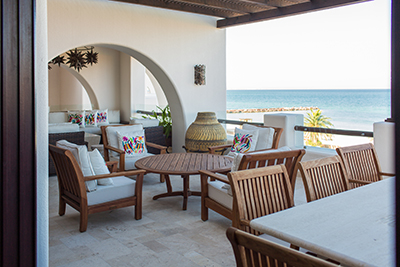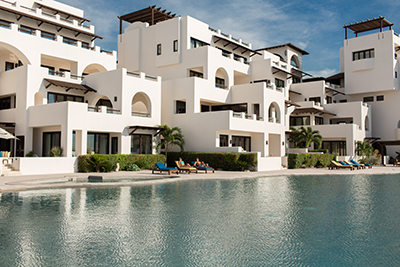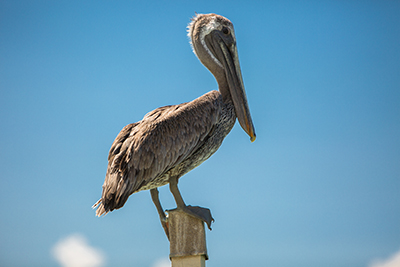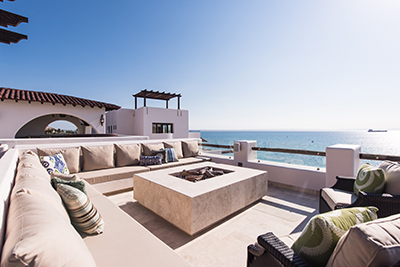WHEN CONSERVATIONIST Jacques Cousteau described the narrow Sea of Cortez, between the Baja California Peninsula and the Mexican mainland, as the world’s aquarium, he wasn’t kidding.
Its azure surface, broken only by gentle waves lapping onto rocky islands that look like giant layer cakes, on a recent visit is suddenly alive with several hundred joyful dolphins.
They leap out of the water, twirl and swim in unison, dive under our skiff and occasionally race in front of us, as if leading me and my companion Jeffrey Curtiss, a real estate developer and de facto boutique hotelier in La Paz, to one of hundreds of coral playgrounds teeming with colorful tropical fish.
“Isn’t this amazing?” Curtiss asks. An English entrepreneur who put his roots down in La Paz a decade ago after he happened to visit his son’s diving school, he still can’t get enough of this paradise.
“This is where I can breathe freely,” he says, recalling his first delirious balmy days away from London’s pollution as a veritable beach bum in nearby Playa Pichilingue. He gorged on chocolate-colored clams, crabs and shrimp at a restaurant under a thatched palapa that has remained unchanged for decades. “It is where the area’s power brokers come to relax,” just a stone’s throw from a modern ferry landing where goods and mainlanders arrive, Curtiss says. He made friends easily because “people are very friendly here and within a few days you feel like a local.”

A few weeks into his self-exile, Curtiss decided to stay.
Although it is southern Baja’s capital, La Paz is laid-back and, true to its name, it is a peaceful backwater with low, unassuming Mission-style buildings, many constructed with cinder blocks. Its 250,000 workaday residents make the place the antithesis of flashy Cabo, just two hours away on Baja’s southern tip.
In 2003, recognizing La Paz’s unstudied charm, Money magazine dubbed it one of the best places to retire to. However, others had noticed it long before. Novelist John Steinbeck described it in his 1950s book The Log From the Sea of Cortez as a world unto itself; entertainers Desi Arnaz and Bing Crosby and actor Clark Gable liked to party there; singer Engelbert Humperdinck owned a hotel on the outskirts of town called La Posada de Engelbert. It still exists, recently refurbished as a five-star hotel called La Posada. Despite these celebrities, La Paz remains largely ignored by American tourists, perhaps because there are no direct international flights to its airport. It’s a good thing. La Paz’s vibrant Alvaro Obregon boulevard, which parallels the Malecón, a wide three-mile-long promenade skirting the bay, is alive at night with Spanish-speaking families strolling by, young adults coursing into bars, and occasionally in the side streets off the main drag, a mariachi band serenading a bridal party in an elegant courtyard restaurant.

Curtiss embraced all this but not the makeshift nature of some of La Paz’s newest buildings. He wanted a home that would rise above the norm in detail and materials. During the last six years, he began building his dream home on 10 acres adjoining El Caimancito Beach, located midway between Pichilingue and La Paz. Keen to sink deeper roots, he also started a date palm farm and a horse ranch on other properties and has helped fund the Bagel Shop, a bakery and cafe in the center of town.
“I go there regularly and meet my other expat friends,” Curtiss says, proffering sumptuous smoked salmon bagel sandwiches he brought along for our picnic back on the boat.
Our dolphin encounter was merely the first of myriad others today in this aquatic universe that includes migrating whales, marlin and dorado fish as well as sea lions basking off Espiritu Santo, an uninhabited island northeast of Pichilingue. Five of the world’s eight species of sea turtles, endangered porpoises, and giant 30-foot-long whale sharks with their signature white spots on charcoal-colored backs also call this area home. I snorkeled gingerly alongside one of these awesome gentle giants as it swam by slowly, sucking up plankton, an arm’s length away.

At sundown, we walked along the wide stretch of beach that borders Curtiss’ aptly named Playa de la Paz enclave and watched the moon rise behind the conjoined white-painted buildings that he has conceived with the help of Guadalajara architect Geraldo Ulate. The 23 residences, with invisible steel and concrete underpinnings to withstand earthquakes, resemble a Moresque Mediterranean village that has grown by accretion.
“I wanted something amazing but also something that belonged here,” Curtiss says. So its handwrought front gate has a sun and moon motif. Arched openings, large floor-to-ceiling windows, trellised roof terraces and sheltered balconies are borrowed from local forms, and all these have views of lush yet drought-resistant gardens surrounding a free-form infinity swimming pool and, just beyond it, the prized sea.
Some of the Playa’s resort-style indoor/outdoor residences, funded along with two other financial partners, are for sale, and a few are occasionally rented to prospective buyers who, with the help of a concierge, can get a sense of the area and the luxurious, spacious homes. For instance, a million-dollar one-bedroom residence is as big as a multibedroom home in the Bay Area, at 3,000 square feet. Even larger Playa residences have up to four bedrooms.

The interiors, some by Canadian architect Alex Chapman and others by Paulina Gutierrez of San Jose del Cabo, are modern, with stateof- the-art Viking kitchens, marble bathrooms and beautiful furnishings, some by local craftsmen. A freestanding poolside gym, located close to a bronze anchor sculpture by Octavio Gonzalez, is open all the time. What’s not easily visible are the desalination plant, which makes seawater in Playa’s taps safer than bottled water, and powerful generators that kick in when electricity flags during a storm.
The surrounding desert landscape is dotted with cactus and acacia, yet the browned backdrop of El Mirador hills turns green after the smallest downpour, and that verdure lines the panoramic road from Playa to the center of La Paz.
Although Baja has been inhabited for millennia, La Paz is a 16th-century creation fueled in part by pearl fishing. The sea, as with all coastal towns, is still its beating heart. A whale museum reverentially displays a whale skeleton in its side yard, and more of Gonzalez’s sea-inspired bronzes of mermaids, breaching whales and even a manta ray in flight grace the Malecón. Jardin Velasco, a square in the center of town in front of the 1861 Dominican Catedral de Nuestra Señora de la Paz, built on the site of an 18th-century Jesuit mission, has a fountain contoured like a mushroom-shaped rock in the Sea of Cortez, a symbolic nod to La Paz’s best asset, the sea.
Curtiss loves all that, he says, but when it comes to new buildings, he wants Playa de la Paz to clear a path that goes “well beyond the box.” playadelapaz.com

Zahid Sardar brings an extensive range of design interests and keen knowledge of Bay Area design culture to SPACES magazine. He is a San Francisco editor, curator and author specializing in global architecture, interiors, landscape and industrial design. His work has appeared in numerous design publications as well as the San Francisco Chronicle for which he served as an influential design editor for 22 years. Sardar serves on the San Francisco Decorator Showcase design advisory board.


